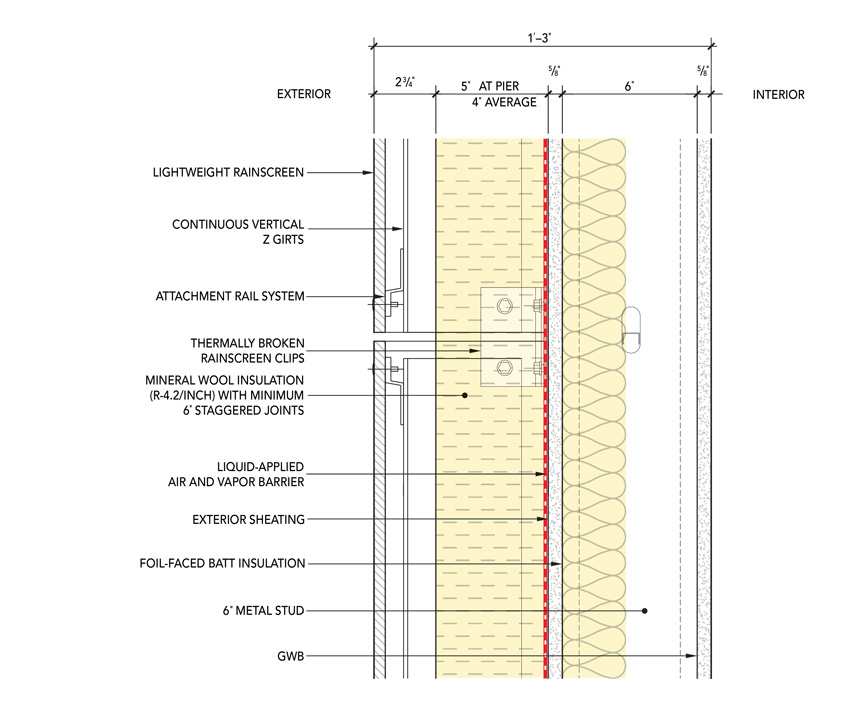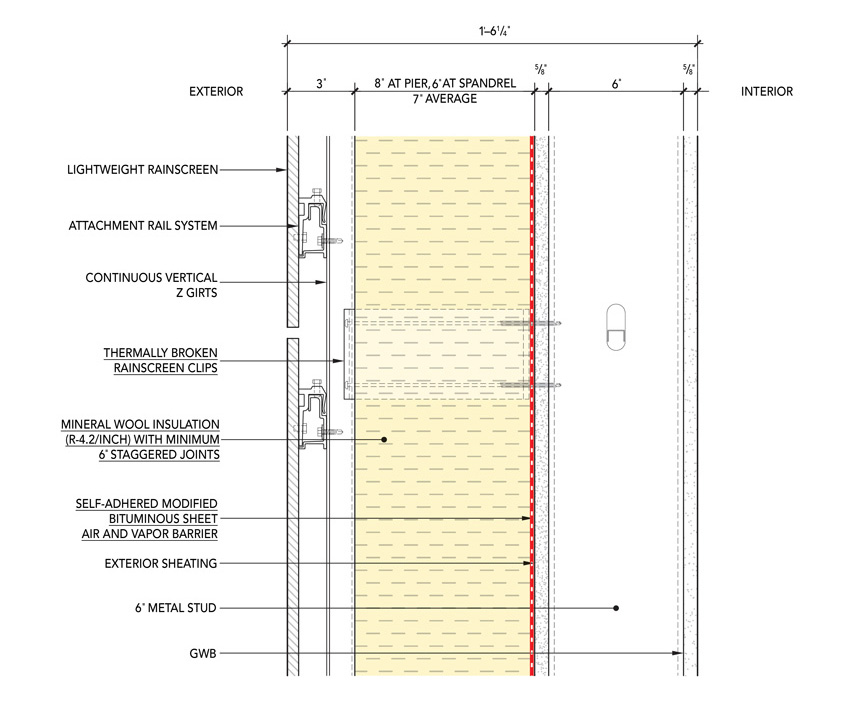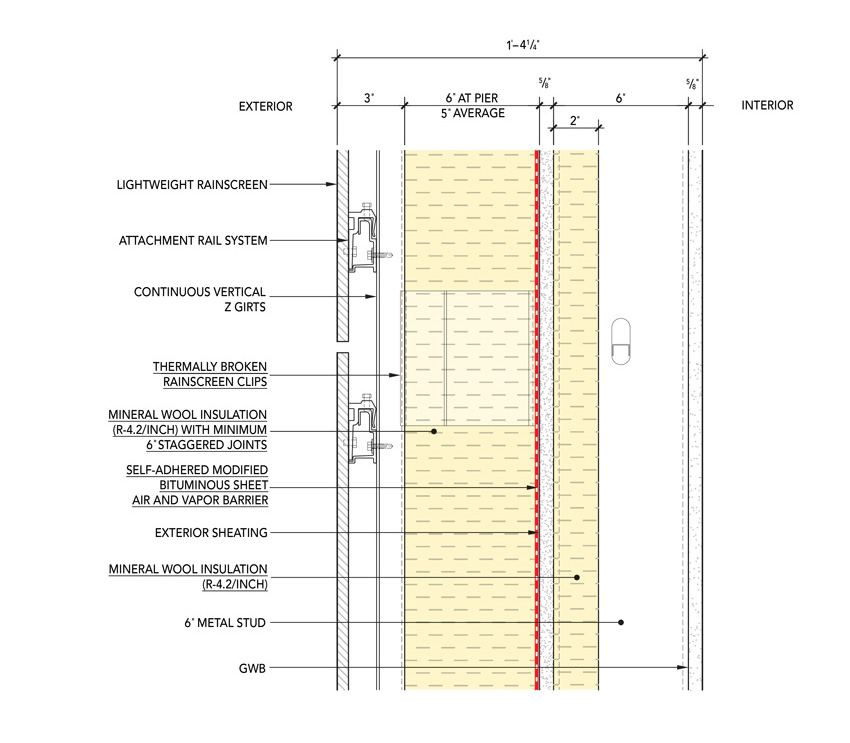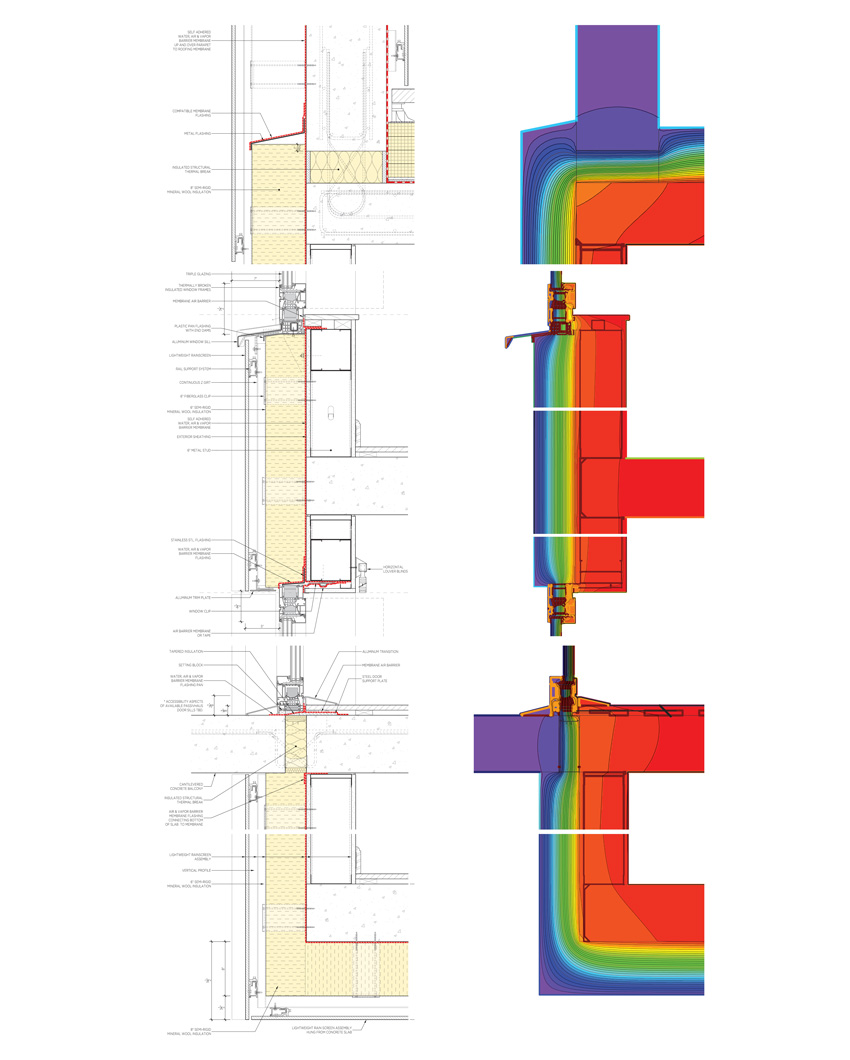Actively Pursuing Passivhaus Enclosures
Curtain Wall and Best Practices
Sharing some valuable tips for achieving Passivhaus requirements with curtain wall systems, Enriquez recommends keeping the architectural form simple (e.g., minimizing changes in planes). “This is not what architects like to hear necessarily, but the more ins and outs, and the more unique conditions, the more projects will be challenged to meet a very high level of performance criteria,” he says.
On a more detailed level, Enriquez encourages designers to anchor the curtain wall system at the slab edge. From a performance standpoint, face-of-slab attachment is preferable to a top-of-slab or below-slab attachment.
“We have done unitized curtain walls both ways, and from a design perspective, face of slab offers a lot of benefits during design,” he explains. “It can be a bit more challenging to install, but the performance benefits should make it a more attractive approach.”
Offering a number of best practices, Moelis advises:
- ensuring that some significant portion of the insulation passes by the edge of slab;
- making sure that all lintels, ties, and facade-support clips are thermally broken;
- documenting, detailing, and correctly building all penetrations through the facade in the field;
- ensuring extensive quality control during fabrication and construction; and
- clearly calling out all details and carefully coordinating unique products and specifications.
Meanwhile, Judah says that mockups are critical, especially with regard to ensuring that the curtain wall is being fabricated and constructed to pass airtightness testing.
“If a curtain wall system has not been designed to meet the Passivhaus airtightness standard of 0.6 air changes per hour at 50 pascals pressure differential, its air leakage will likely exceed that limit,” Snyder says.
Similarly, if the curtain wall system hasn’t been designed to thermally isolate the exterior of the framing system from the interior, there’s a good chance that thermal bridging will jeopardize the building’s energy, condensation, and comfort risk limit requirements.
To help mitigate all these issues, Snyder highly recommends choosing Passivhaus-certified curtain wall and glazing systems.“Manufacturers of Passivhaus Institute-certified curtain wall systems are aware of the need for a continuous air barrier and will have designed their components to be ultra airtight when installed correctly,” Snyder says. “They will also provide suggestions for how their systems should interface with other building components to achieve thermal-bridge free and airtight construction.”
Leveraging the PHPP Software Tool
Another advantage of specifying Passivhaus-certified curtain wall systems is their compatibility with the Passive House Planning Package (PHPP) software, which is required by all projects pursuing certification.
With all Passivhaus-certified product data preloaded into the software, building teams can avoid the additional effort and costs associated with digging up curtain wall performance data to input into the PHPP. Furthermore, they can avoid any deductions required by some uncertified products.
The tool is considered the most well researched and designed energy modeling software on the market when it comes to ultra high-performance buildings, according to Dylan Lamar, CPHC, an architect with Portland-based Green Hammer. He says PHPP outputs annual heating demand, maximum heating load, summer thermal comfort with active cooling, annual cooling demand, maximum cooling load, summer thermal comfort with passive cooling, frequency of overheating events, and annual primary energy demand for the whole building. “I feel the PHPP v9 is the best modeling software currently on the market,” he says.
“As an energy modeling software program, PHPP allows the user to accurately account for certain types of common thermal bridging using therm and associated calculations,” Zakrzewski explains. “We have found that there can be up to 30 percent loss in insulation efficiency when these losses are not accounted for so PHPP software very accurately represents the designs that are created,” he explains.
Similarly, Everhart describes PHPP as essential for modeling low-energy buildings, particularly as the design relates to the shading context of the surrounding neighborhood/landscape. The software enables the building team to “see the impact on the whole building energy performance of specific glazing decisions like locations and orientation of glazed building elements, size, operability, choice of glazing and frame types, use and extent of shading devices, as well as being able to see the impact of glazing choices on occupant comfort levels.”
With the help of the PHPP tool, designers can best size and locate glazing, and perform parametric studies of the differences in whole building performance given a set of glazing design decisions, including comparing the performance of a given manufacturer’s glazing products.
Included in PHPPs latest version 9 is a “traffic light” system that indicates whenever glazing units are losing so much heat that their interior surfaces do not meet Passivhaus criteria, thereby requiring supplemental heat to be supplied along the glazed perimeter for occupant comfort, according to Everhart.
If building teams opt for nonstandard curtain wall installation—for example, attaching to different building assemblies than shown in a manufacturer’s standard details—this needs to be calculated for use in PHPP as well.
“Manufacturers can typically recommend the person who did their typical detail calculations to assist the design team with per square inch (PSI) value calculations,” Everhart says.
With specific curtain wall systems built into the Components tab in PHPP’s latest version, this accounts for heat losses due to bolts and glass carriers, as well as the geometry of the installation. As an excellent tool for calculating thermal bridging energy loss, Zakrzewski will then leverage this valuable information to tweak his designs in order to drive the thermal loss down as much as possible.
To assist building teams with the PHPP software and other energy modeling, a list of Passivhaus-trained consultants and designers can be found at www.passivhausplaner.eu/index.php?lang=en-GB.
Passivhaus for New York High Rises
While the center of Passivhaus activity remains in Europe, momentum is slowly but surely ramping up here in the United States. Case in point, FXFOWLE makes a strong case for Passivhaus in New York City in the firm’s new “Feasibility Study to Implement the Passivhaus Standard on Tall Residential Buildings” report.



Images courtesy of FXFOWLE
A Passivhaus version of the base-case assembly uses thermally improved fiberglass attachment clips and uninterrupted, continuous insulation. From left: base case: lightweight rain screen steel stud backup (R-17.65); Passivhaus proposal: lightweight rainscreen with steel stud and exterior insulation (R-26); and Passivhaus alternate: lightweight rainscreen steel stud backup and interior & exterior insulation (R-26).
With a goal of investigating cutting-edge energy efficiency practices, influencing New York’s housing policy toward more ambitious energy and greenhouse gas reduction targets and encouraging local Passivhaus adoption, results from the firm’s analysis of a 593,000-square-foot, 26-story multifamily mixed-use building in Jamaica, Queens, strongly suggest that Passivhaus is applicable to tall buildings in New York City.
“Since New York has a challenging climate with cold winters and hot, humid summers, these results also suggest that Passivhaus is broadly applicable to cities in many climates,” state Judah and Piselli in the report. “Achieving the standard appears financially viable, and will become increasingly more cost effective as the design and construction industry becomes more experienced and familiar with Passivhaus.”
As the City’s overall aggregate energy use is so high, with heating accounting for the largest piece of the pie in terms of energy use and carbon footprint, Judah sees Passivhaus’ extremely aggressive approach to reducing heating loads as a huge opportunity.
Furthermore, the highly dense space and lack of roof area for solar energy makes net-zero designs difficult to achieve in the city, whereas Passivhaus provides a viable model for very low-energy buildings.
For the high-rise case study, the Passivhaus design—achieved via additional insulation, reduced thermal bridging, simplified air-barrier installation strategies, and triple-glazed insulated windows—is projected to save 47 percent in overall primary energy use. “These changes allow mechanical systems to be substantially reduced or eliminated, thereby reducing first costs, operations and maintenance costs, and replacement costs,” write Judah and Piselli.

Image courtesy of FXFOWLE
Shown are assembled details of a lightweight rainscreen steel stud backup (left) and corresponding thermal bridge analyses of various junctions (right).
Describing the insulation and airtightness as the keys to achieving Passivhaus standards, the FXFOWLE architects recommend following the Air Barrier Association of America’s quality assurance protocol.
For this project, “we built in extra time and money for the quality assurance of the envelope construction,” Judah says. “We hope that eventually this would become standard practice and there would be no additional costs, but I think this level of due diligence is pretty critical.”
Additional best practices involve furnishing detailed 3-D drawings of key junctions for the contractor/subcontractors, bringing in Passivhaus-certified designers and installers, and recruiting a construction manager/general contractor who is highly committed to the Passivhaus goal.









